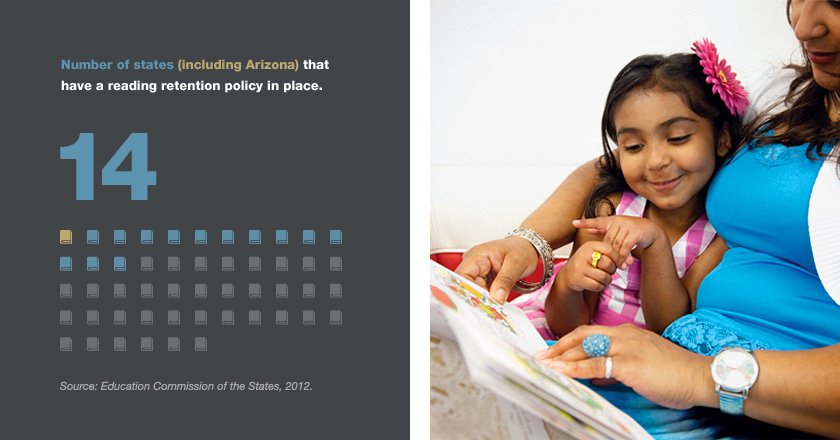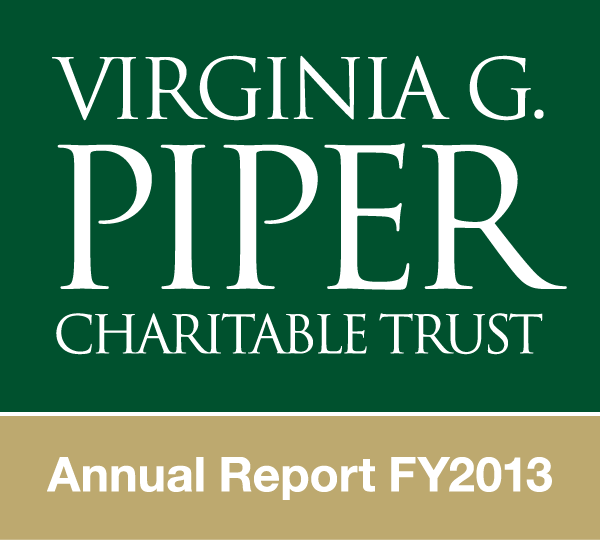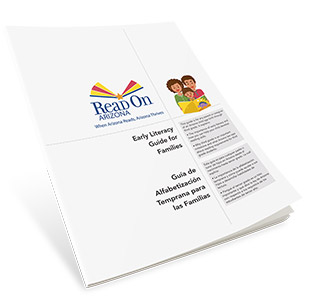Reading the Way to a Stronger
Arizona: A United Fight to Improve
Early Childhood Literacy
by Karen Werner
“This is my dream position,” says Terri Clark, of her job as Arizona’s literacy director. After living in California for more than twenty years and serving as executive director of Bring Me A Book, a statewide early literacy organization, Clark has returned to Arizona to help her home state address its early literacy problems.

Terri Clark, Arizona Literacy Director.
Photo Credit: Suzanne Starr
I really understand how you get literacy providers to work together, but also how to weave in community stakeholders, funders, and the business sector.
If her job is a dream, it is also a monumental challenge. But it is her ability to unite disparate parties that has earned Clark her reputation as an innovator. Rather than linger on the scope of the problem, Clark focuses on what collaboration can mean. “I really understand how you get literacy providers to work together, but also how to weave in community stakeholders, funders, and the business sector,” she says. That’s good, because this Mesa-bred executive has a mountain to climb.
The Problem
Arizona is fighting a literacy crisis. And Piper Trust is committed to helping. In the 2013-14 school year, Arizona’s mandatory retention policy, Move On When Reading (ARS 15-701), takes effect. This law requires that third-grade students who test in the “falls far below” range (estimated at 4,000) be held back. In addition, there are approximately 17,500 third-grade students below proficiency, placing them at risk. The Move On When Reading retention policy illuminates the importance of addressing this crisis—and addressing it early. Research shows that children entering kindergarten without the skills they need to succeed in school rarely read proficiently by third grade, a milestone that is a strong predictor of future academic and vocational success. “Up until third grade, children are learning to read,” says Marilee Dal Pra, Piper Trust’s vice president of programs. “Once they hit fourth grade, the expectation is that they know how to read. So now they’re reading to learn. If they’re not prepared for that shift and aren’t reading at grade level, they are at a huge disadvantage.” The research is chilling. Students who cannot read well by the end of third grade face diminished future prospects. Seventy-four percent of kids who are poor readers in third grade remain poor readers in ninth grade. Worse, unskilled readers are unlikely to graduate from high school. To complicate matters, many of Arizona’s 800,000 children under age 9 face significant barriers to school readiness, including poverty, limited exposure to English, and lack of access to books.

Providing children with books to read has shown to be as effective for reading achievement as attending summer school.
Photo Credit: Bruce Peterson

The Arizona Parent Kit.
Photo Credit: Bruce Peterson
The Trust has long recognized the need for investment in literacy. A decade ago, Piper Trust, Harvard Graduate School of Education, and Tufts University Center for Reading and Language Research partnered to implement an after-school reading remediation program; research supporting the program’s effectiveness was funded by a federal grant. The program took failing second- and third-grade readers in Chandler and Moon Valley and provided remediation after school. “We learned what much research since has shown—that remediation takes a lot of resources and, while it can be effective, it’s difficult to make course corrections as a child gets older,” says Dal Pra.
That understanding led Piper to look for other, more effective ways to make a significant difference, so the Trust shifted its strategy and explored investing in early childhood efforts that would support a child holistically on “the front end.” For instance, to provide support for parents during their children’s earliest years, Piper Trust created the Arizona Parent Kit, which provides a wealth of resources to help parents navigate their babies’ critical first years, including a book to encourage them to read to their children. (Now administered by First Things First, an initiative that funds childhood development, health, and education for kids 5 and under, the kit is distributed to more than 65,000 new parents each year.)
If a child doesn’t start kindergarten ready to go—hasn’t seen a letter, hasn’t been sounding things out—the child is already behind.
Today, experts know that the foundational skills for literacy must be in place before a child enters kindergarten. “If a child doesn’t start kindergarten ready to go—hasn’t seen a letter, hasn’t been sounding things out—the child is already behind,” Dal Pra says. So the Trust has funded several research-based programs designed to improve early childhood literacy. Programs include Reach Out and Read, which provides pediatric medical offices with books to give to children; and Raising a Reader, Parents as Teachers, and Motheread, which provide parents with the tools to help build early literacy skills in their young children.
Still, the literacy problem continues to grow, so Piper looked for an opportunity to address it in a unified way. “Arizona is in a moment in time where there is much more pressure to get this right and do it quickly,” Dal Pra says. “We have to ensure that all of our children have the supports necessary to get them reading at grade level.”


Arizona’s Superintendent of Public Instruction John Huppenthal and Secretary of State Ken Bennett talk with Terri Clark about early childhood literacy at Peralta Elementary School.
Tackling the state’s literacy crisis requires a united effort. Educators, families, businesses, public agencies, and communities all must play a role. Building on the momentum of the national Campaign for Grade-Level Reading, last year Read On Arizona was launched, a statewide initiative to advance children’s language and literacy. Piper Trust, Helios Education Foundation, and Arizona Community Foundation joined forces with Arizona Department of Education, First Things First, and Head Start State Collaboration Office as founding partners to support this statewide effort to ensure children can read at the end of third grade.
This initiative is different from anything the Trust has supported before in that it is a public/private collaborative of government agencies, philanthropic organizations, and other community stakeholders leveraging every resource to improve literacy outcomes for Arizona’s children.
Through discussion, the partners agreed that Piper would fund the state literacy director position and the Read On Arizona partners would support the director. “The point is to have a person whose job is dedicated to aligning all of our resources,” says Dal Pra.
This approach has fostered a shared agenda with priorities that move the collaborative effort forward. We find where everybody has common ground.
“The uniqueness of what they’ve done here in Arizona—and they did it purposefully—is having the literacy director be a shared position among all six partners,” Clark says. “This approach has fostered a shared agenda with priorities that move the collaborative effort forward. We find where everybody has common ground.”
The goals of Read On Arizona are clear—and high. The program aims to increase significantly the number of kids demonstrating school readiness in language and literacy by kindergarten. The program also strives to increase the percentage of students reading at or above grade level by the end of third grade to 100 percent. In short, Read On Arizona has set a target of building an efficient early literacy system that delivers the right program at the right time to every child in the state.
Read On Arizona published the Early Literacy Guide for Families as a resource for parents and caregivers to help their children, from birth through third grade, develop strong reading skills.
What sets Read On Arizona apart is the strong collaborative spirit between the partners, each of which has a defined role and a responsibility that fits.
One example is the summer reading collaborative. The Arizona State Library has always had a strong summer reading program and the state Department of Education had its own summer reading program, too. “We talked about taking the best of both programs and expanding our reach and our impact,” Clark says. “Then we went to First Things First as an organization with critical early childhood expertise and said, ‘We’d really like you to be involved in the summer reading promotion. It’s actually a perfect way to get families with young kids to understand what they can be doing.’ They’ve been a great partner for this, promoting and getting the message out. None of that would have happened without Read On saying, ‘You have more in common here than you realize.”
The Read On Arizona partners meet every month, which promotes shared leadership, vision, and accountability. They are learning what their tactical strengths are and where they can each step in and help. In the process, they are discovering ways to join forces and align resources so they use every dollar wisely to ensure kids get access to the supports and services they need.

A family builds reading skills in a young child through the Raising a Reader program.
Photo Credit: Bruce Peterson
Read On Arizona developed a process so that cities, towns, or larger communities can become Read On communities. The program launched with four communities: Phoenix, Tucson, Flagstaff, and Yuma. Today there are 11. (Buckeye, Chandler, Cochise County, Goodyear, Greater Phoenix, Mesa and Sahuarita are now Read On communities, as well.) Each of the communities has plans in place to address literacy challenges such as school readiness, summer learning loss, and chronic absence.
“Suddenly you have the whole community talking and focusing on early literacy and how they can make it a priority. That’s where the momentum comes from,” Clark says. “It gives the network the infrastructure it needs at both the state level and the boots-on-the-ground, local level.”
Each community uses the same process to develop a literacy plan that is specific to that community. “You look at certain key data points, your third-grade reading scores, countywide assessment. Then suddenly you can know what services are being offered in the community you’re focused on, what gaps there are, and then devise a plan designed to fill those gaps,” Clark says. “We can then say here’s a continuum of supports and services in that particular area that have been vetted.”
With the third-grade retention policy going into effect this fall, Read On Arizona also has a role to play there. Because many families know little or nothing about the new policy, the collaborative is creating a Move On When Reading toolkit that talks about the policy, what it means, and what families can do to support literacy at home. “That’s the role we’re starting to see Read On Arizona play: that technical assistance and filling the gap in the literacy continuum,” Clark says.
Moving forward, Read On Arizona will methodically connect the dots among standards, programs, and needs. And though the program goals are lofty and the to-do list lengthy, Dal Pra is confident much can be achieved. “We have partners coming together—philanthropic, public, nonprofit—aligning around the common goal to turn this literacy issue in Arizona around. We are all in this, working together, and have to hold each other accountable to making a difference in these kids’ lives,” she says.

Young reading advocates and future leaders with Terri Clark.
That is pressure Terri Clark feels, but not anything that prevents her from embracing her role as Arizona literacy director. In fact, the chance to make a difference for her home state is part of her dream.
“This is focused around literacy but it’s so much bigger than literacy. It really is about Arizona’s future,” she says. “If we want the Arizona that can compete on a global scale and we want the kind of workforce we need, then you have to invest in literacy as a foundational skill that’s not optional. The end goal is really the success of Arizona.”


